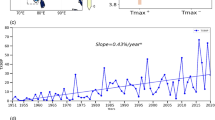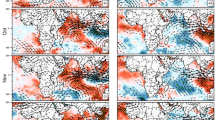Abstract
In this study, tropical cyclone data from China Meteorological Administration (CMA) and the ECMWF reanalysis data for the period 1958–2001 was used to propose a possible mechanism for the impacts of air-sea interaction on the activity of tropical cyclones (TCs) affecting China. The frequency of TCs affecting China over past 40 years has trended downward, while during the same period, the air-sea interaction in the two key areas of the Pacific region has significantly weakened. Our diagnoses and simulations suggest that air-sea interactions in the central North Pacific tropics and subtropics (Area 1) have an important role in adjusting typhoon activities in the Northwest Pacific in general, and especially in TC activity affecting China. On the contrary, impacts of the air-sea interaction in the eastern part of the South Pacific tropics (Area 2) were found to be rather limited. As both observational analysis and modeling studies show that, in the past four decades and beyond, the weakening trend of the latent heat released from Area 1 matched well with the decreasing Northwest Pacific TC frequency derived from CMA datasets. Results also showed that the weakening trend of latent heat flux in the area was most likely due to the decreasing TC frequency over the Northwest Pacific, including those affecting China. Although our preliminary analysis revealed a possible mechanism through which the air-sea interaction may adjust the genesis conditions for TCs, which eventually affect China, other relevant questions, such as how TC tracks and impacts are affected by these trends, remain unanswered. Further in-depth investigations are required.
Similar content being viewed by others
References
Bao, Q., G. X. Wu, Y. M. Liu, J. Yang, Z. Z. Wang, and T. J. Zhou, 2010: An introduction to the coupled model FGOALS1.1-s and its performance in East Asia. Adv. Atmos. Sci., 27(5), 1131–1142, doi: 10.1007/s00376-010-9177-1
Buzbee, B. L., G. H. Golub, and C.W. Nielson, 1970: The method of odd/even reduction and factorization with application to Poisson’s equation, Part II. STAN-CS-70-155, LA-4288, Los Alamos Scientific Laboratory.
Chan, J. C. L., and K. S. Liu, 2004: Global warming and Western North Pacific typhoon activity from an observational perspective. J. Climate, 17, 4590–4602.
Chan, J. C. L., 2006: Comments on “Changes in Tropical Cyclone Number, Duration, and Intensity in a Warming Environment”. Science, 311, 1713b.
Chan, J. C. L., 2008: Decadal variations of intense typhoon occurrence in the western North Pacific. Proc. Royal Soc. London, 464, 249–272.
Chen, L. S., and Y. H. Ding, 1979: A Panorama of Typhoon Activities in the Western North Pacific. Science Press, Beijing, 109pp. (in Chinese)
Ding, Y. H., 1989: Diagnosis Methods of Weather Dynamics. Science Press, Beijing, 293pp. (in Chinese)
Ding, Y. H., and G. Q. Hu, 2003: A study on water vapor budget over China during the 1998 severe flood periods. Acta Meteorologica Sinica, 61(2), 129–145. (in Chinese)
Edwards, J. M., and A. Slingo, 1996: Studies with a flexible new radiation code. I: Choosing a configuration for a large-scale model. J. Roy. Meteor. Soc., 122, 689–719.
Haarsma, R. J., J. F. B. Mitchell, and C. A. Senior, 1993: Tropical disturbances in a GCM. Climate Dyn., 8, 247–257.
Holtslag, A. A. M., and B. A. Boville, 1993: Local versus nolocal boundary-layer diffusion in a global climate model. J. Climate, 6, 1825–1842.
Hoyos, C. D., P. A. Agudelo, P. J. Webster, and J. A. Curry, 2006: Deconvolution of the factors contributing to the increase in global hurricane intensity. Science, 312, 94–97.
Kong, F., 1988: Comparisons between FFT and SOR on Solving the 2-D Poisson Equations. Scientia Meteorologica Sinica, 18(1), 19–28. (in Chinese)
Krishnamurti, T. N., T. R. Correa, M. Latif, and G. Daughenbaugh, 1998: The impact of current and possibly future sea surface temperature anomalies on the frequency of Atlantic hurricanes. Tellus, 50, 186–210.
Li, C. Y., 2000: Introduction to Climate Dynamics. Meteorological Press, Beijing, 515pp. (in Chinese)
Li, Y., and L. S. Chen, 2005: Numerical study on impacts of boundary layer fluxes over wetland on sustention and rainfall of land falling tropical cyclone. Acta Meteorologica Sinica, 63(5), 683–694. (in Chinese)
Ooyama, K., 1969: Numerical simulation of the life cycle of tropical cyclone. J. Atmos. Sci., 25(1), 3–40.
Palmén, E. H., 1948: On the formation and structure of tropical cyclones. Geophysica, 3, 26–38.
Palmer, T. N., G. J. Shutts, and R. Swinbank., 1986: Alleviation of a systematic westerly bias in general circulation and numerical weather prediction models through an orographic gravity wave drag parameterization. Quart. J. Roy. Meteor. Soc., 112, 1001–1039.
Ren, F., J. Liang, G. Wu, W. Dong, and X. Yang., 2012: Reliability analysis of climate change of tropical cyclone Aactivity over the western North Pacific. J. Climate, 24, 5887–5898.
Slingo, J. M., 1987: The development and verification of a cloud prediction scheme for the ECMWF model. Quart. J. Roy. Meteor. Soc., 113, 899–927.
Wang, Z. Z., R. C. Yu, Q. Bao, T. J. Zhou, Y, M, Liu, P. F. Wang, and G. X. Wu, 2007: A comparison of the atmospheric circulations simulated by the FGOALSs and SAMIL. Chinese J. Atmos. Sci., 31(2), 202–213. (in Chinese)
Zhang, F. Q., H.W. Du, and Q. R. Jiang, 1994: A numerical study of the boundary layer effect on mature typhoon. Journal of Tropical Meteorology, 10(2), 108–114. (in Chinese)
Zhou, T. J., and X. H. Zhang, 2002: The atmosphere-ocean heat flux exchange in the Indian Ocean. Chinese J. Atmos. Sci., 26(2), 161–170. (in Chinese)
Author information
Authors and Affiliations
Corresponding author
Rights and permissions
About this article
Cite this article
Ren, F., Bai, L., Wu, G. et al. A possible mechanism of the impact of atmosphere-ocean interaction on the activity of tropical cyclones affecting China. Adv. Atmos. Sci. 29, 661–674 (2012). https://doi.org/10.1007/s00376-012-1028-9
Received:
Revised:
Published:
Issue Date:
DOI: https://doi.org/10.1007/s00376-012-1028-9




